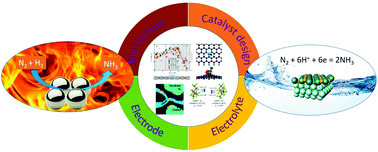Our official English website, www.x-mol.net, welcomes your
feedback! (Note: you will need to create a separate account there.)
Recent advances in catalysts, electrolytes and electrode engineering for the nitrogen reduction reaction under ambient conditions
Nanoscale ( IF 5.8 ) Pub Date : 2020/02/21 , DOI: 10.1039/d0nr00412j Junbo Hou 1, 2, 3, 4 , Min Yang 4, 5, 6, 7 , Junliang Zhang 1, 2, 3, 4
Nanoscale ( IF 5.8 ) Pub Date : 2020/02/21 , DOI: 10.1039/d0nr00412j Junbo Hou 1, 2, 3, 4 , Min Yang 4, 5, 6, 7 , Junliang Zhang 1, 2, 3, 4
Affiliation

|
With the conventional Haber–Bosch NH3 synthesis in industry requiring harsh pressures and high temperatures, artificial N2 fixation has been long sought after. The electrochemical nitrogen reduction reaction (NRR) could offer a solution by allowing NH3 production under ambient conditions. In this review, important recent findings on theoretical calculations and experimental exploration on the NRR at room temperature are systematically reviewed. Firstly, we discuss the mechanism of electrochemical heterogeneous catalysis for the NRR. The NRR is a multi-proton coupled electron transfer (PCET) process which implies that in addition to catalyst surface size effects, ligand and strain effects will also significantly influence the binding energy of the adsorbed N atoms, reaction intermediates and product species. Electrocatalysts including metals, metal nitrides, metal oxides and carbon-based materials will also be discussed at length. A linear scaling relationship seems to limit the NRR activity on most metals and metal oxides. Metal nitrides, however, follow the Mars–van Krevelen (MvK) mechanism which usually shows a lower potential energy barrier compared to the associative mechanism. Carbon-based materials and some single atom catalysts exhibit improved activity and selectivity due to ligand effects. Thus, electrolytes containing a proton donor might play a crucial role in the NRR. The limiting concentration of proton donors and the rate of proton transport to the active sites might be effective factors in boosting the selectivity of the NRR. Specifically, ionic liquids with high N2 solubility demonstrate much larger faradaic efficiency and would be promising candidates for use in NRR processes. Inspired by the characteristics of PCET, four strategies of electrode engineering were introduced including limiting protons, tuning the electron transport, modifying the electrode structure facilitating mass transport, and completely changing the NRR mechanism inspired by bio-nitrogenase and Li mediated N2 fixation.
中文翻译:

环境条件下氮还原反应的催化剂,电解质和电极工程的最新进展
在工业上需要苛刻的压力和高温的常规Haber–Bosch NH 3合成中,人造N 2固定一直以来都是人们所追求的。电化学氮还原反应(NRR)可以通过允许NH 3提供解决方案在环境条件下生产。在这篇综述中,系统地综述了有关室温下NRR的理论计算和实验探索方面的最新重要发现。首先,我们讨论了NRR的电化学非均相催化机理。NRR是一种多质子耦合电子转移(PCET)过程,这意味着除催化剂表面尺寸效应外,配体和应变效应还将显着影响吸附的N原子,反应中间体和产物种类的结合能。也将详细讨论包括金属,金属氮化物,金属氧化物和碳基材料在内的电催化剂。线性比例关系似乎限制了大多数金属和金属氧化物的NRR活性。但是,金属氮化物 遵循Mars-van Krevelen(MvK)机制,与关联机制相比,该机制通常显示出较低的势能垒。碳基材料和某些单原子催化剂由于配体效应而显示出改进的活性和选择性。因此,含有质子供体的电解质可能在NRR中起关键作用。质子供体的极限浓度和质子向活性位的迁移速率可能是提高NRR选择性的有效因素。特别是高氮离子液体 质子供体的极限浓度和质子向活性位点迁移的速率可能是提高NRR选择性的有效因素。特别是高氮离子液体 质子供体的极限浓度和质子向活性位点迁移的速率可能是提高NRR选择性的有效因素。特别是高氮离子液体2溶解度显示出更大的法拉第效率,并且有望用于NRR工艺。受PCET特性的启发,介绍了四种电极工程策略,包括限制质子,调节电子传输,修改电极结构以促进质量传输以及完全改变生物氮酶和Li介导的N 2固定激发的NRR机制。
更新日期:2020-04-03
中文翻译:

环境条件下氮还原反应的催化剂,电解质和电极工程的最新进展
在工业上需要苛刻的压力和高温的常规Haber–Bosch NH 3合成中,人造N 2固定一直以来都是人们所追求的。电化学氮还原反应(NRR)可以通过允许NH 3提供解决方案在环境条件下生产。在这篇综述中,系统地综述了有关室温下NRR的理论计算和实验探索方面的最新重要发现。首先,我们讨论了NRR的电化学非均相催化机理。NRR是一种多质子耦合电子转移(PCET)过程,这意味着除催化剂表面尺寸效应外,配体和应变效应还将显着影响吸附的N原子,反应中间体和产物种类的结合能。也将详细讨论包括金属,金属氮化物,金属氧化物和碳基材料在内的电催化剂。线性比例关系似乎限制了大多数金属和金属氧化物的NRR活性。但是,金属氮化物 遵循Mars-van Krevelen(MvK)机制,与关联机制相比,该机制通常显示出较低的势能垒。碳基材料和某些单原子催化剂由于配体效应而显示出改进的活性和选择性。因此,含有质子供体的电解质可能在NRR中起关键作用。质子供体的极限浓度和质子向活性位的迁移速率可能是提高NRR选择性的有效因素。特别是高氮离子液体 质子供体的极限浓度和质子向活性位点迁移的速率可能是提高NRR选择性的有效因素。特别是高氮离子液体 质子供体的极限浓度和质子向活性位点迁移的速率可能是提高NRR选择性的有效因素。特别是高氮离子液体2溶解度显示出更大的法拉第效率,并且有望用于NRR工艺。受PCET特性的启发,介绍了四种电极工程策略,包括限制质子,调节电子传输,修改电极结构以促进质量传输以及完全改变生物氮酶和Li介导的N 2固定激发的NRR机制。











































 京公网安备 11010802027423号
京公网安备 11010802027423号